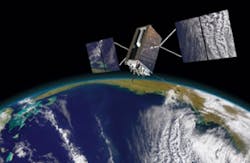NEWTOWN, Pa., Oct. 11, 2011. The Lockheed Martin [NYSE : LMT] team developing the U.S. Air Force’s next generation Global Positioning System has turned on initial power to the program’s pathfinder spacecraft, known as the GPS III Non Flight Satellite Testbed (GNST). The milestone gives the team high confidence in meeting the scheduled launch of the first GPS III satellite in 2014.The GPS III program is the lowest risk solution to constellation sustainment and the most affordable path to meet the needs of military, commercial and civilian users worldwide. GPS III will improve position, timing services, navigation and provide advanced anti-jam capabilities yielding superior system security, reliability and accuracy.The GPS III team is first developing the GNST, a full-sized prototype of the GPS III spacecraft used to identify and solve issues prior to the first space vehicle. This approach improves production predictability, reduces risk, increases mission assurance and lowers overall program costs. The GNST, populated with fully functional non-flight boxes, provides space vehicle design level validation; early verification of ground, support, and test equipment; and early confirmation and rehearsal of transportation operations.
“Turning initial power on for the GNST is a major milestone for the GPS III team demonstrating we are well on track to deliver the first satellite for launch in 2014,” said LtCol Don Frew, the U.S. Air Force’s GPS III program manager.
The GPS III team has installed harnesses, power subsystem components, tracking, telemetry and control hardware on the GNST structure to support phased checkout of the integrated design. Flight software versions have also been delivered for all of the spacecraft and payload computer processors. In parallel, GPS III teammate ITT is integrating the GNST Navigation Payload at their facility in Clifton, NJ.
Successfully powering on the GNST demonstrates initial mechanical integration, validates the GNST’s interfaces and leads the way for electrical and integrated hardware-software testing. The GNST will be shipped to Lockheed Martin’s GPS III Processing Facility in Denver late this year to demonstrate Assembly, Integration and Test procedures. It will then be delivered to Cape Canaveral Air Force Station in the summer for 2012 for pathfinding activities at the launch site.
Building on lessons learned from previous GPS space programs; the U.S. Air Force’s GPS III acquisition approach is considered by many to be the model for future space acquisition.

